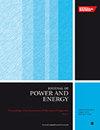基于高效稳定准则的水泵水轮机转轮高压侧多目标遗传算法优化
IF 1.1
4区 工程技术
Q3 ENGINEERING, MECHANICAL
Proceedings of the Institution of Mechanical Engineers, Part A: Journal of Power and Energy
Pub Date : 2023-06-09
DOI:10.1177/09576509231181933
引用次数: 1
摘要
抽水蓄能电站必将在调峰移谷中扮演更重要的角色,因此对运行稳定性的需求逐渐被视为与效率同等重要的标准。本文引入“掠”、“弯”、“弯”等新概念,对水轮机转轮高压侧的几何形状进行了系统的创新设计。在此基础上,提出了一个兼顾高效与稳定的多目标优化过程,包括实验设计(DoE)、元模型生成、多目标遗传算法(MOGA)和自组织映射(SOM)。选择了最终的优化方案并进行了数值验证。与原转轮相比,泵工况效率从91.7%提高到91.9%,水轮机工况效率从92.3%提高到92.8%。小GVO时S裕度从89.34°增加到90.23°,大GVO时S裕度从79.56°增加到80.29°。此外,完全消除了驼峰不稳定区。并基于局部水力损失率(LHLR)法进行了流动特性比较。在设计点上,优化后的转轮对于水轮机模式明显降低轮毂和转轮中部区域的水力损失,对于泵模式则略微降低停留叶区域的水力损失。对于非定常特性,HPS能较好地调节相应流量工作点的水力损失分布,大大降低了水轮机模式下的S非定常特性,消除了泵模式下的驼峰非定常特性。我们相信本文提出的方法可以把液压机械的设计提高到一个新的水平。本文章由计算机程序翻译,如有差异,请以英文原文为准。
Optimization on high-pressure side of pump-turbine runner based on high efficiency and stability criterion via multi-objective genetic algorithm method
Pumped storage power plants are doomed to play a more important role in peak-valley shifting hence the demand for operation stability is gradually regarded as an equal important criterion as high efficiency. In our paper, new concepts, namely “swept,” “bowed (lean),” and “twisted” are introduced to systematic innovative design the geometry of high-pressure side (HPS) of a pump-turbine runner. Thereafter, a multi-objective optimization process, which consists of design of experiment (DoE), meta model generation, multi-objective genetic algorithm (MOGA), self-organization map (SOM) and takes both high efficiency and stability discipline into account is produced. The final optimization plan is selected and testified numerically. Compared to the original runner, the efficiency is improved from 91.7% to 91.9% at pump mode and improved from 92.3% to 92.8% at turbine mode. Moreover, the S margin is increased from 89.34° to 90.23° at small GVO and increased from 79.56° to 80.29° at large GVO. Besides, hump unsteady region is completely eliminated. Moreover, the flow characteristic comparation is conducted based on local hydraulic loss rate (LHLR) method. For design points, the optimized runner obviously decreases the hydraulic loss in hub and middle part of runner domain for turbine mode and slightly decrease the hydraulic loss in stay vane region for pump mode. For unsteady characteristics, HPS can better adjust the hydraulic loss distribution in corresponding discharge operating points, largely decreasing S unsteady characteristic in turbine mode and eliminating hump unsteady characteristic in pump mode. We believe that the methods proposed in our paper can bring the design of hydraulic machinery to a new level.
求助全文
通过发布文献求助,成功后即可免费获取论文全文。
去求助
来源期刊

CiteScore
3.30
自引率
5.90%
发文量
114
审稿时长
5.4 months
期刊介绍:
The Journal of Power and Energy, Part A of the Proceedings of the Institution of Mechanical Engineers, is dedicated to publishing peer-reviewed papers of high scientific quality on all aspects of the technology of energy conversion systems.
 求助内容:
求助内容: 应助结果提醒方式:
应助结果提醒方式:


